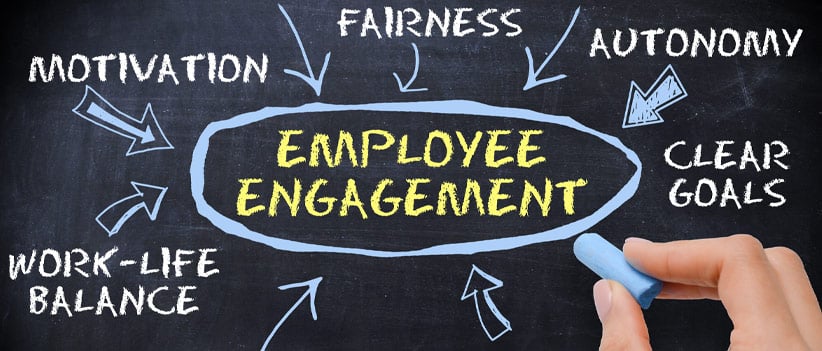(un)Successful employee engagement… You might see this more often than you like. Just imagine you have a new employee start at your company; full of energy and passion, pretty much bouncing off the walls with new ideas and suggestions. Then a few months go by, and instead of arriving early and putting effort into their work, they almost start on time, so to say, and count down the hours until they have to go home. They have no energy and dread coming to work each day, their enthusiasm quickly fades and eventually abruptly stops. How do you prevent this and promote successful employee engagement?
When you have a high level of engaged employees, it lowers the risk of turnover, boosts customer satisfaction, increases the company’s overall chance of success and decreases the risk of poor health and wellbeing. Here are some steps on how to implement, encourage and have successful employee engagement.

1. Don’t Skip Onboarding and Training.
With new employees, they want to know what their responsibilities are, and how to do their job effectively. Without a proper introduction to their role, new employees may find it difficult to remain motivated and involved. According to one SHRM (Society for Human Resource Management) survey, one-third of new hires left their jobs after only six months.

Throughout this period, training needs to be introduced and monitored with constant reassurance and open accessibility to help and support. By implementing this, it symbolises to new employees that the company and management team value their growth and development.
Amber Hyatt director of product marketing at SilkRoad, defined the onboarding process as a systematic and thorough approach to uniting a new employee with a company and its culture, as well as getting the new employee the tools and information needed to become a productive member of the team. “A well-designed, fun and engaging onboarding process has a significantly greater effect on employee engagement and retention when compared to the old-school mentality of one-day orientation,” she said.
By maintaining this, your employees will feel a sense of purpose and gain knowledge on how to further themselves within their role and career.
2. Set Short-Term and Long-Term Goals.
Show and teach your new teammates the vision of the company and what is expected of them. Great managers can set expectations for their staff, yet convey an apparent authority that doesn’t burden their employees.

According to a Forbes article on How to Establish a Culture of Employee Engagement, ‘you can set general company goals as well as goals within each department. That way, each employee knows how their work is impacting the departmental and overall success of your business. By reaching goals, this can encourage employee engagement.’
I had past jobs where I didn’t know what my manager wanted, or even what they expected of me. I had to figure it out on my own, and even when I would ask questions, I would get hit back with an angry response of disbelief and shock. Every job will be unique, but it’s the ones that are open, direct and honest that make a difference.
3. Implement a Method for Regular Updates and Communicate Often.
Keep your team ‘in the know’ and strategise a method on what works best for each individual. The American Marketing Association says that ‘each employee has a unique communication style, and effective leaders need to understand what works best for him or her. There are multiple ways to check in with employees that will make them feel at ease and able to speak freely. Training sessions, written memos, email communications, and regular meetings can all work toward positive engagement with employees’.

Express to your team members their achievements and what they can improve on. Ask them for any feedback or concerns that they may have. Guide and lead them to want to succeed and prosper in the company/business. Motivate them by checking in on them weekly and encourage them to want to complete and produce exceptional work.
4. Incentive Programs to Acknowledge Employees.
An excellent method for improving and encouraging employee engagement is by adding incentives and rewards to staff that have produced stellar work, incredible performance and shown a positive work ethic. You shouldn’t have to wait until quarterly or annually reviews to express to your employees how appreciative you are of their hard work.
You could gather the team together to mention individuals who have shown incredible initiative, and perhaps present a little gift like a bottle of wine or if well deserved, a lovely bonus.

You want to motivate your staff and excite with them the prospect of incentives. In that not-so-great example I shared with you, let’s say I never wanted to get nominated again or work hard enough to receive that award or any other.
5. Don’t Micromanage.
Employees don’t want to be watched over every second and told what to do for every little requirement. There should be some space to grow and come up with ideas on their own. Being told what to do and how to do it doesn’t allow any motivation for your employees to be engaged with their work.

If you are always watching over your staff and causing them to work like robots, they can’t develop and have the freedom to problem solve by themselves. Your team members will lack the initiative to think of their own ideas and solutions, consequently causing them to disengage as an employee.
If you work within a team of several managers, you need to create a format and structure on who instructs and leads which employees. I once worked for a company where there were several managers, and every day they told me different methods and techniques on how to perform my tasks. If I did it one way, it was seen as wrong to another manager. I felt watched continuously and treated like a child. There was no room to grow, and I did eventually become a robot who did what they were told and still dealt with negative responses.
6. Propose Health and Well-Being Programs.
Employee health and well-being are highly regarded as meaningful and impactful to the employee’s performance, productivity, and creativity.
A Gallup study found that 62% of engaged employees feel their work positively affects their physical health. Yet that number drops to 39% among non-engaged employees and down to a mere 22% among employees who are actively disengaged.
Likewise, 54% of self-assessed disengaged respondents say their work has an adverse effect on their health, while 51% see a negative impact on their well-being.

Wellness, Physical and Mental is IMPORTANT.
Snack Action states that wellness challenges are another great way to foster friendships at work, such as bike to work challenges, fitness competitions, or group fitness activities can all bring people together.
Companies can kill two birds with one stone with this tactic. Helping improve employee health and wellness while simultaneously creating a fun-filled environment for bonding and personal connection.
Keep your employees engaged by offering mental health support for those in need. A past employer of mine was so attentive and supportive of their staff when it came to mental health. Where even if you had a bad day they always made us feel that we could talk to them. You want to be able to reach out to your staff on a personal level and make them feel safe to open up about their problems. Be more than their employer and boss; be their friend.
7. Improve Leadership.
Make an effort to spend time with your employees. Whether it’s formal training, performance management or a simple chat and coffee break. Be passionate and confident about your role and the company you work for. Set an example for your employees and build trust within your team.
You may have heard the old proverb of “people don’t quit jobs, they quit managers”; a saying that shows how poor management and leadership can hinder employees engagement and retention.

By training and hiring stellar managers, you can help by significantly increasing your employee’s engagement and lower the retention throughout your company.
8. Give Employee Feedback.
When working within a team, each person’s performance can show you how the team is working as a whole. If one person is disengaged or struggling within their performance; offer and give them positive feedback. It will facilitate and make them aware of their situation. Maybe even how best to overcome and fix it.

Communication!
HR professional, Tracy Russell, put in a recent blog interview amidst US local councils, that it’s about “developing a culture based on open communication, so your employees feel comfortable to give their honest opinion and trust it will be actioned.”
I once had an exit interview where I was asked to fill out a questionnaire on my time working for that company. I was told to be honest and open. After I completed the form, I instantly regretted what I wrote, as I was scared of who would read it. Despite the fact, I no longer worked there. I didn’t want any negativity to circulate my name and time there. Unfortunately, my time at that company was not a positive one, and I never felt that I could be honest. You never want to impact your employees in this matter negatively. Throughout their employment and even after, you want to build a relationship on trust so they can share with you feedback; whether you like it or not.
9. The Small Things Count.
Do you ever notice that when someone says “good job” or “thank you” it puts a little smile on your face and pushes you to try harder? It does for me. In fact, in my past jobs, I would tell other staff members that exact appreciative line. Many times people would say to me they only ever heard me say that. That it cheered them up when they were having a bad day. Wouldn’t it be great if managers would do that too? I’m not saying all managers do this. But I do believe that in all roles we tend to forget to mention the little things.

We’re All Different… But Still the Same
Everyone wants to feel appreciated and told that they are doing a great job. I’m not saying to do it every chance you get. Only mention it when it’s deserved and even when it’s not; encourage and engage with your staff to then reward them with the subtle but effective: “good job”; a small thing that counts.
These nine steps may work for you, or perhaps you’ve tried them already and no success. What has worked for you and your company? Remember that every person and organisation is different, and what works for you may not work for the next. Good luck with your successful employee engagement.
For information on Recruitment Software and Applicant Tracking Systems, MyRecruitment+ can help.





Blog comments